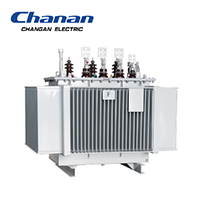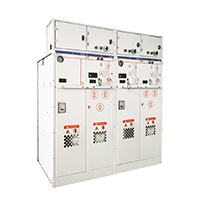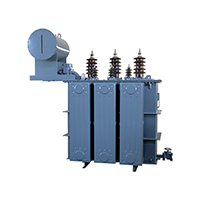How Does an Oil Immersed Transformer Work?

 by changan electric
by changan electricOil immersed transformers are fundamental components in modern electrical power systems, silently working to ensure efficient electricity distribution. If you’ve ever wondered how these crucial devices operate, this article breaks down their working principle in easy-to-understand terms.
What is an Oil Immersed Transformer?
An oil immersed transformer, also known as a oil filled transformer, is a type of electrical transformer where the core and windings are immersed in a special insulating oil. This oil serves two critical functions: it provides enhanced electrical insulation and acts as an efficient cooling medium to dissipate heat generated during operation. These transformers are widely used in power distribution systems, from residential lighting to industrial energy supply.
The Core Working Principle
At its heart, an oil immersed transformer operates on the fundamental principle of electromagnetic induction.
When an alternating current (AC) flows through the primary winding, it creates a constantly changing magnetic field. This magnetic field then induces a voltage in the secondary winding. The ratio of turns between the primary and secondary windings determines whether the voltage is stepped up or down.
The insulating oil plays a vital role in this process. By immersing the core and windings in oil, the transformer achieves better insulation between components, prevents corona discharge, and manages the substantial heat generated during energy transfer.
Key Components and Their Roles
Iron Core: Typically constructed from high-quality, cold-rolled, grain-oriented silicon steel sheets. The core provides a low-reluctance path for magnetic flux. Its design, often using step-lap technology, minimizes no-load loss and current, reducing noise and improving efficiency.
Windings: These are the current-carrying conductors wrapped around the core. High-voltage windings are often made with enamel or paper-insulated wire, while low-voltage windings may use a mix of enamel wire, paper-covered wire, or copper strip. They are arranged to ensure balanced ampere-turn distribution and strong short-circuit resistance.
Insulating Oil: This is the lifeblood of the transformer. It possesses excellent insulating properties, preventing electrical arcs between components. Furthermore, its ability to absorb and transfer heat is crucial for maintaining safe operating temperatures.
Tank and Cooling System: The sturdy tank houses the core, windings, and oil. Many modern transformers feature a corrugated tank design. These corrugations increase the surface area for better heat dissipation and allow the tank to adapt to the thermal expansion and contraction of the oil, often making a separate conservatory (oil drum) unnecessary.
Protective Devices: These include components like the pressure relief valve, signal thermometer, and gas relay (Buchholz relay). They continuously monitor the transformer’s health and provide alerts or take action in case of internal faults, overheating, or pressure buildup, ensuring safe and reliable operation.
The Crucial Dual Role of Transformer Oil
Transformer oil is not just a coolant; it’s a sophisticated component with two interdependent jobs.
1. Insulation: The oil’s primary electrical function is to prevent short circuits and electrical breakdown between energized parts and the grounded tank. It has a high dielectric strength, meaning it can withstand high electric stresses without conducting electricity. By impregnating the paper insulation on the windings, the oil significantly enhances the overall insulation system’s effectiveness.
2. Cooling: As current flows through the windings, I²R losses (copper losses) and core iron losses generate heat. The oil absorbs this heat from the core and windings. As the oil heats up, it becomes less dense and naturally rises towards the top of the tank and the cooling fins. As it cools down in the fins or radiators, it becomes denser and sinks back down, creating a natural convection current. This continuous cycle efficiently transfers heat from the active parts to the external environment, preventing dangerous overheating. The top oil temperature is typically monitored and should not exceed 90°C, with alarms often set at 80°C to prevent insulation degradation.
Why Choose an Oil Immersed Transformer?
Oil immersed transformers offer several compelling advantages that make them a preferred choice for many applications:
High Efficiency and Lower Losses: Advanced core materials and designs result in minimal energy loss during conversion, saving on operational costs.
Excellent Heat Dissipation: The oil’s thermal capacity allows these transformers to handle higher overloads compared to some dry-type models, often capable of operating at 150% loading for extended periods.
Superior Insulation and Protection: The oil system effectively isolates components from moisture and atmospheric oxygen, slowing down the aging process of the internal insulation.
Long Service Life: With proper maintenance, these transformers are known for their durability and long operational life.
Strong Short-Circuit Withstand: Robust winding construction and design contribute to a high ability to withstand the mechanical and thermal stresses of short-circuit events.
A Reliable Choice for Power Distribution
Oil immersed transformers are engineering marvels that play a critical role in delivering electricity safely and efficiently. Their simple yet effective working principle, relying on electromagnetic induction and the dual role of insulating oil, has proven to be a reliable technology for decades.
For those seeking a robust and efficient solution for applications like power plants, substations, industrial and mining facilities, ports, and airports, a well-designed oil immersed transformer is an excellent choice. Modern sealed designs with corrugated fins offer maintenance-free operation and reliable performance in various environments.

Explore Reliable Power Solutions
Looking for a high-efficiency, low-loss transformer for your project? Consider the Changan 11kv Oil Immersed Distribution Transformer. It features a fully sealed, maintenance-free corrugated tank design for superior cooling and longevity. Built with a high-quality silicon steel core and oxygen-free copper windings, it ensures strong short-circuit resistance and significant energy savings. Ideal for both indoor and outdoor installations in diverse environments.
Contact us today to find the perfect power transformation solution for your specific needs and discover how our transformers can enhance your system’s reliability and efficiency.




